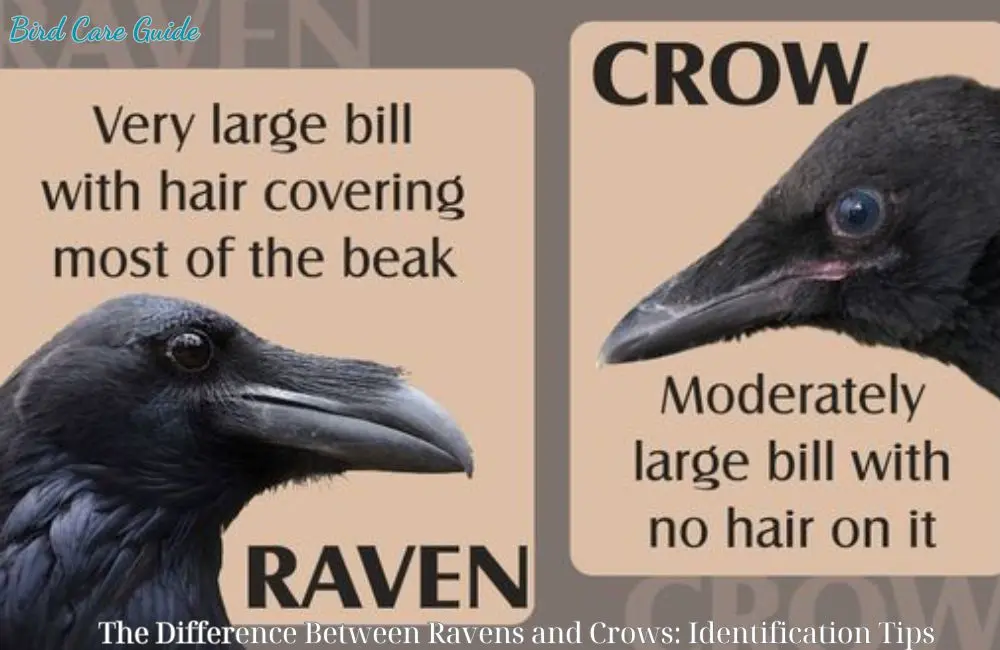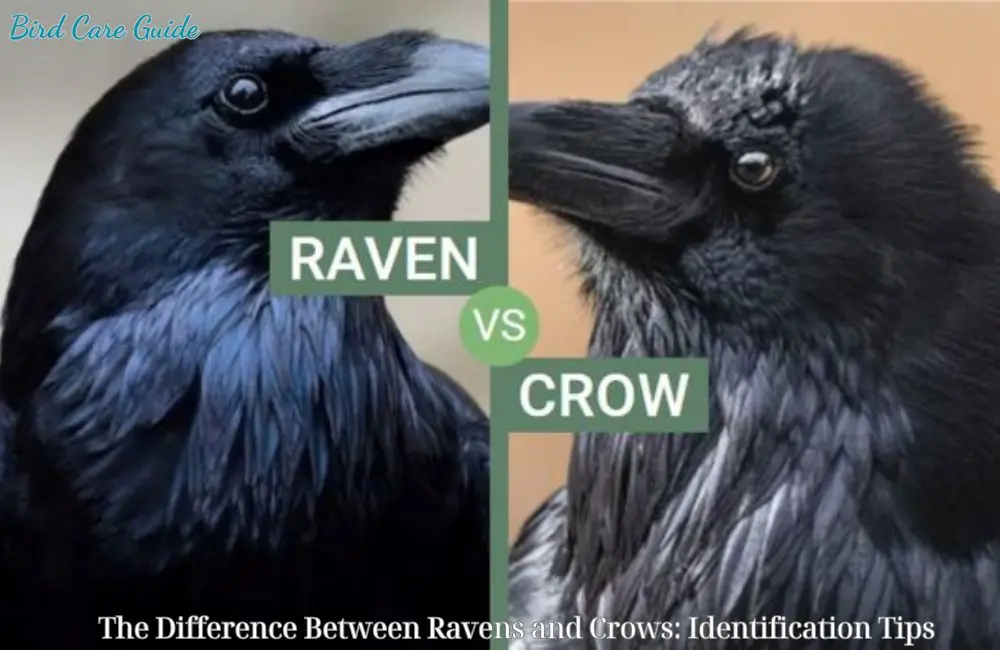Birdwatchers and nature enthusiasts often encounter two of the most intelligent and fascinating birds: ravens and crows. Despite their similar appearance, these birds have distinct differences that can help identify them. This article “Bird Care Guide” will delve into the difference between ravens and crows, providing detailed identification tips and insights into their behaviors, habitats, and unique traits.
Physical Differences

Size and Shape
One of the most noticeable differences between ravens and crows is their size. Ravens are generally larger than crows. On average, ravens can reach a length of 24 to 27 inches with a wingspan of 46 to 54 inches, while crows are smaller, measuring 17 to 21 inches in length with a wingspan of 32 to 40 inches.
In addition to size, their shapes differ:
- Ravens: Have a more robust and heavier build. They have a thicker neck and a larger, more curved beak.
- Crows: Are more slender and have a smaller, more pointed beak.
Tail Shape
The shape of the tail feathers is another distinguishing feature:
- Ravens: Have wedge-shaped or diamond-shaped tails when spread out during flight.
- Crows: Have fan-shaped tails, with feathers of even length.
Feather Characteristics
Ravens and crows both have black plumage, but the texture and sheen of their feathers can vary:
- Ravens: Often have a more shaggy appearance, especially around the throat area. Their feathers also have a glossy, iridescent sheen that can appear blue or purple in the sunlight.
- Crows: Have smoother, more uniform feathers with a less pronounced sheen.
Vocalizations
Calls and Sounds
The difference between ravens and crows is particularly evident in their vocalizations. Ravens produce a variety of deep, resonant calls, often described as a croaking or guttural “kraa-kraa” sound. They are also known for their ability to mimic sounds, including human speech and other animal calls.
Crows, in contrast, have a higher-pitched, more cawing sound. Their familiar “caw-caw” call is more nasal and less resonant than the raven’s call. Crows are also vocal communicators and can produce a wide range of sounds, including clicks, rattles, and other complex vocalizations.
Behavioral Context of Vocalizations
Ravens use their deep calls to communicate over long distances, often in open landscapes like mountains and deserts. Their calls can convey information about food sources, territorial boundaries, and social interactions. Crows use their calls more frequently in urban and suburban environments, where they communicate with family members and alert others to potential threats.
Behavior and Social Structure
Group Behavior
The social behavior of ravens and crows differs significantly:
- Ravens: Are often seen alone or in pairs, as they are more solitary birds. They are known to form strong pair bonds and work together with their mate.
- Crows: Are highly social and are usually found in larger groups called murders. They are known for their communal roosting, where hundreds or even thousands of crows can gather together, especially in urban areas.
Intelligence and Problem-Solving
Both ravens and crows are highly intelligent birds, but they exhibit different types of problem-solving abilities:
- Ravens: Are known for their exceptional problem-solving skills and have been observed using tools and solving complex puzzles in the wild.
- Crows: Also exhibit advanced problem-solving abilities and have been documented using tools, recognizing human faces, and even holding funerals for dead members of their group.
Playfulness
Ravens are particularly noted for their playful behavior. They have been observed engaging in aerial acrobatics, sliding down snow-covered roofs, and playing games with other animals. Crows are playful as well, but this behavior is more commonly associated with ravens.
Habitat and Range
Ravens
Ravens are more adaptable to a variety of habitats and are often found in more remote or wild areas:
- Habitat: Ravens prefer forests, mountains, deserts, and tundras. They are less common in urban areas compared to crows.
- Range: Ravens have a wider range and can be found across the Northern Hemisphere, including North America, Europe, and Asia.
Crows
Crows are highly adaptable and thrive in a range of environments, including urban settings:
- Habitat: Crows are common in cities, towns, farmlands, and forests. They are highly adaptable to human environments.
- Range: Crows are widespread across North America, Europe, and Asia, with several different species found in these regions.
Feeding Habits
Diet
Both ravens and crows are omnivorous and have similar diets, but there are some differences in their feeding habits:
- Ravens: Tend to forage alone or in pairs and are more likely to hunt for small animals, insects, and carrion. They are also known to cache food for later consumption.
- Crows: Are more opportunistic feeders and are often seen scavenging in groups. They eat a wide variety of foods, including fruits, seeds, insects, small animals, and human food waste.
Foraging Behavior
The way ravens and crows forage can also be a clue to their identification:
- Ravens: Are more likely to search for food in more secluded areas and are adept at finding and storing food.
- Crows: Are often seen scavenging in more populated areas and can frequently be found around trash bins, parks, and streets.
Reproduction and Lifespan
Nesting
The nesting habits of ravens and crows are another distinguishing factor:
- Ravens: Build large, sturdy nests high up in trees, cliffs, or other tall structures. They use sticks and branches to construct their nests and line them with softer materials.
- Crows: Also build nests in trees, but their nests are typically smaller and less robust than those of ravens. They use twigs and line their nests with grass, bark, and other soft materials.
Lifespan
Ravens generally have a longer lifespan compared to crows:
- Ravens: Can live up to 10-15 years in the wild, with some individuals reaching up to 20 years.
- Crows: Typically have a lifespan of around 7-8 years in the wild, though some can live longer in captivity.
Cultural Significance
Mythology and Folklore
Both ravens and crows hold significant places in mythology and folklore around the world, often symbolizing different things:
- Ravens: Are often associated with mystery, intelligence, and transformation. In Norse mythology, the god Odin had two ravens, Huginn and Muninn, who represented thought and memory. Ravens are also seen as messengers in many cultures.
- Crows: Are commonly associated with cunning, adaptability, and change. They appear in various cultural stories and myths, sometimes seen as tricksters or omens.
Symbolism
The symbolism of ravens and crows varies across cultures, but both birds are often seen as symbols of intelligence and resourcefulness. They are revered for their problem-solving skills and adaptability, making them subjects of fascination and admiration.
Practical Tips for Identification the difference between ravens and crows
Field Guide and Binoculars
When trying to identify ravens and crows in the wild, having a good field guide and a pair of binoculars can be incredibly helpful. A field guide will provide visual aids and descriptions to compare, while binoculars allow you to observe the birds from a distance without disturbing them.
Observe Behavior
Pay close attention to the behavior of the birds you are observing. Note their vocalizations, social interactions, and foraging habits. This can provide valuable clues to their identity.
Note Habitat
Consider the habitat where you are observing the birds. If you are in a remote, wild area, you are more likely to encounter ravens. In contrast, if you are in an urban or suburban setting, crows are more common.
Compare Physical Features
Use the physical features described earlier, such as size, tail shape, and beak structure, to differentiate between ravens and crows. These visual cues can be some of the most straightforward ways to tell the two birds apart.





